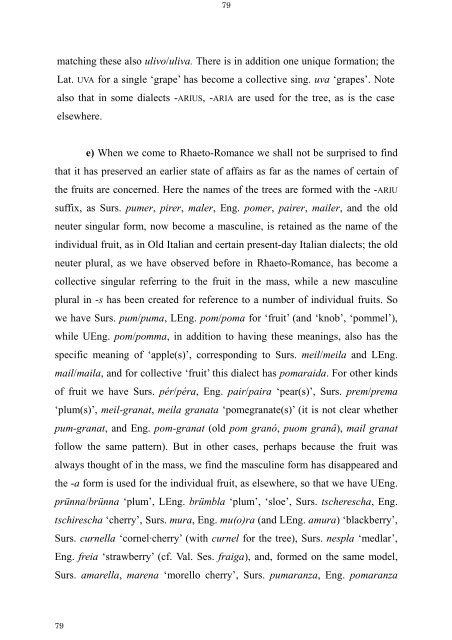The Latin Neuter Plurals in Romance - Page ON
The Latin Neuter Plurals in Romance - Page ON
The Latin Neuter Plurals in Romance - Page ON
Create successful ePaper yourself
Turn your PDF publications into a flip-book with our unique Google optimized e-Paper software.
79<br />
79<br />
match<strong>in</strong>g these also ulivo/uliva. <strong>The</strong>re is <strong>in</strong> addition one unique formation; the<br />
Lat. UVA for a s<strong>in</strong>gle ‘grape’ has become a collective s<strong>in</strong>g. uva ‘grapes’. Note<br />
also that <strong>in</strong> some dialects -ARIUS, -ARIA are used for the tree, as is the case<br />
elsewhere.<br />
e) When we come to Rhaeto-<strong>Romance</strong> we shall not be surprised to f<strong>in</strong>d<br />
that it has preserved an earlier state of affairs as far as the names of certa<strong>in</strong> of<br />
the fruits are concerned. Here the names of the trees are formed with the -ARIU<br />
suffix, as Surs. pumer, pirer, maler, Eng. pomer, pairer, mailer, and the old<br />
neuter s<strong>in</strong>gular form, now become a mascul<strong>in</strong>e, is reta<strong>in</strong>ed as the name of the<br />
<strong>in</strong>dividual fruit, as <strong>in</strong> Old Italian and certa<strong>in</strong> present-day Italian dialects; the old<br />
neuter plural, as we have observed before <strong>in</strong> Rhaeto-<strong>Romance</strong>, has become a<br />
collective s<strong>in</strong>gular referr<strong>in</strong>g to the fruit <strong>in</strong> the mass, while a new mascul<strong>in</strong>e<br />
plural <strong>in</strong> -s has been created for reference to a number of <strong>in</strong>dividual fruits. So<br />
we have Surs. pum/puma, LEng. pom/poma for ‘fruit’ (and ‘knob’, ‘pommel’),<br />
while UEng. pom/pomma, <strong>in</strong> addition to hav<strong>in</strong>g these mean<strong>in</strong>gs, also has the<br />
specific mean<strong>in</strong>g of ‘apple(s)’, correspond<strong>in</strong>g to Surs. meil/meila and LEng.<br />
mail/maila, and for collective ‘fruit’ this dialect has pomaraida. For other k<strong>in</strong>ds<br />
of fruit we have Surs. pér/péra, Eng. pair/paira ‘pear(s)’, Surs. prem/prema<br />
‘plum(s)’, meil-granat, meila granata ‘pomegranate(s)’ (it is not clear whether<br />
pum-granat, and Eng. pom-granat (old pom granó, puom granâ), mail granat<br />
follow the same pattern). But <strong>in</strong> other cases, perhaps because the fruit was<br />
always thought of <strong>in</strong> the mass, we f<strong>in</strong>d the mascul<strong>in</strong>e form has disappeared and<br />
the -a form is used for the <strong>in</strong>dividual fruit, as elsewhere, so that we have UEng.<br />
prünna/brünna ‘plum’, LEng. brümbla ‘plum’, ‘sloe’, Surs. tscherescha, Eng.<br />
tschirescha ‘cherry’, Surs. mura, Eng. mu(o)ra (and LEng. amura) ‘blackberry’,<br />
Surs. curnella ‘cornel·cherry’ (with curnel for the tree), Surs. nespla ‘medlar’,<br />
Eng. freia ‘strawberry’ (cf. Val. Ses. fraiga), and, formed on the same model,<br />
Surs. amarella, marena ‘morello cherry’, Surs. pumaranza, Eng. pomaranza









